BLACKEAGLE
SENIOR MEMBER
U.S. Air Force's most sophisticated stealth jet is beaten in dogfight by plane from 1970s... despite being the most expensive weapon in history
Published: 17:36 GMT, 30 June 2015 | Updated: 20:29 GMT, 30 June 2015
It’s the most expensive weapon in history but America's F-35 stealth jet has been outperformed by a 40-year-old F-16 jet in a dogfight.
A mock air battle was held over the Pacific Ocean between the cutting-edge F-35 - meant to be the most sophisticated jet ever - and an F-16, which was designed in the 1970s.
But according to the test pilot, the F-35 is still too slow to hit an enemy plane or dodge gunfire. So far it has cost the US military more than $350billion.
Scroll down for video
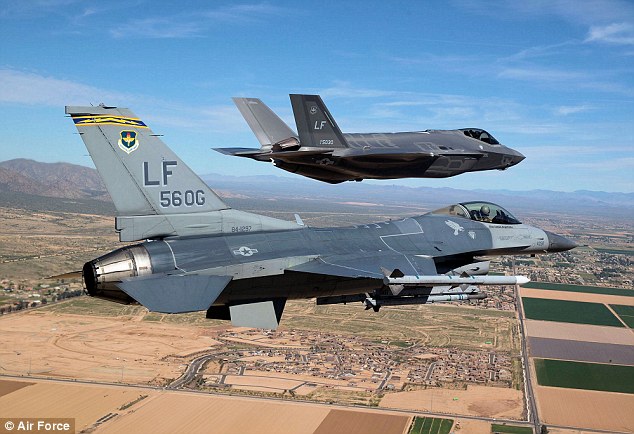
Head-to-head: The F-35 (background) and the F-16 (foreground) took to the skies in a dogfight to determine how the highly-anticipated F-35 compares to its predecessor
The dogfight, which was staged in January near Edwards Air Force Base, California, was designed to test the F-35’s ability in close-range combat at 10,000 to 30,000 feet.
Both the F-35 pilot and the F-16 pilot were attempting to ‘shoot down’ the other.
But, according to the F-35 pilot’s report, which has only recently been made public, the jet performed so appallingly that he deemed it completely inappropriate for fighting other aircraft within visual range.
He reported that the F-35 – designed by Lockheed Martin – was at a ‘distinct energy disadvantage for every engagement’ despite the F-16 being weighed down by two drop tanks for extra fuel.
The F-35 pilot reported a number of aerodynamic problems, including ‘insufficient pitch rate’ for the jet’s nose while climbing - resulting in the plane being too cumbersome to dodge enemy fire.
He said that a half-million-dollar custom-made helmet that gives pilots a 360-degree view outside the plane meant he was unable to comfortably move his head inside the cramped cockpit. This meant the F-16 could approach from behind without him noticing.
‘The helmet was too large for the space inside the canopy to adequately see behind the aircraft,’ he wrote in the five-page brief.
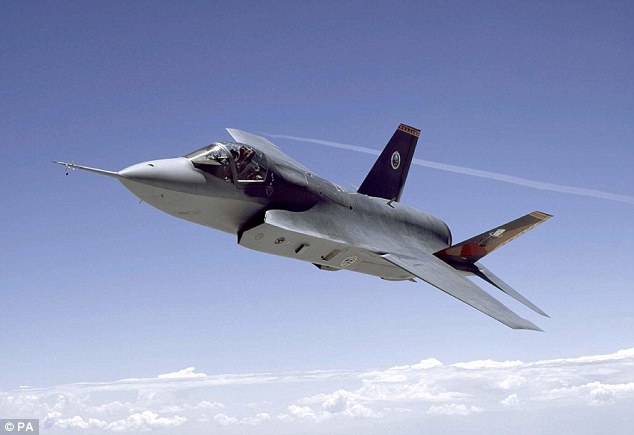
'Flying computer': U.S. military leaders have extoled the virtues of the F-35 jets, which are intended to 'combine advanced stealth capabilities with fighter aircraft speed and agility'
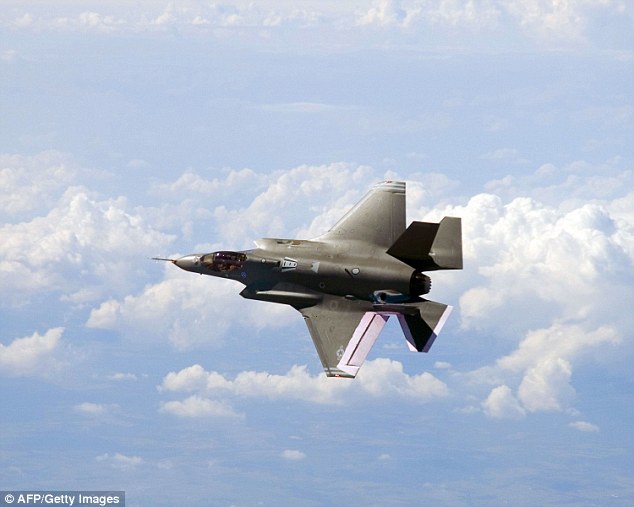
But a series of setbacks has delayed production by up to eight years and put it $263billion over budget so far
See through the eyes of an F-35 fighter pilot's high tech helmet
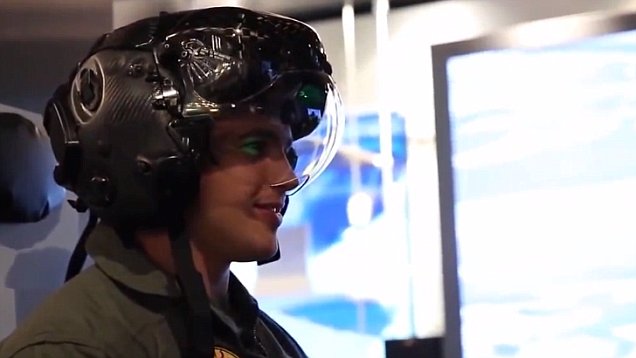
The F-35 jet was one of the most highly anticipated advancements in military history.
However a series of setbacks has delayed production by up to eight years and put it $263billion over budget so far.
The spiralling costs are due to a number of factors, including engine problems that caused one jet to burst into flames during take-off last May.
Air Force Lt. Gen. Chris Bogdan, who is in charge of the F-35 programme, said the planes had been plagued by simple mistakes. These included everything from wingtip lights that did not meet Federal Aviation Administration (FAA) standards to tires that could not cope with the landings.
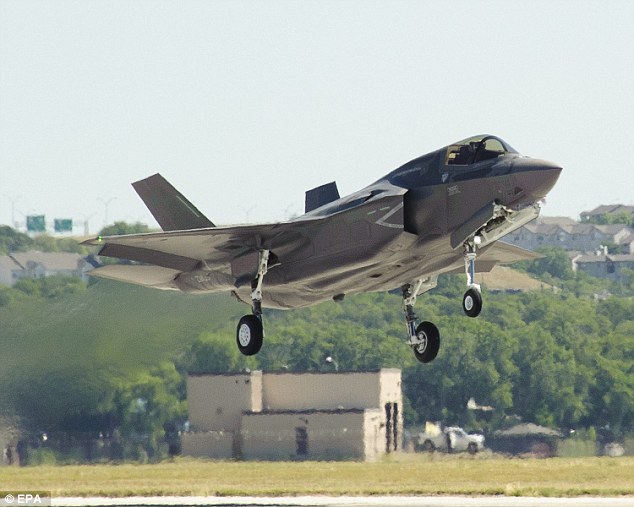
Britain's baby: This F-35 is intended for use by the RAF, although an official said it won't be ready for years
But military bosses have been quick to extol the virtues of the stealth multirole fighter, which is predicted to be vastly superior to its fourth-generation predecessors.
Marine Lt Gen. Robert Schmidle said the planes were like flying computers and that they could detect an enemy five to 10 times faster than the enemy could detect it.
And Lt Col David Burke told 60 Minutes last year: ‘I’m telling you, having flown those other airplanes, it’s not even close at how good this airplane is and what this airplane will do for us.’
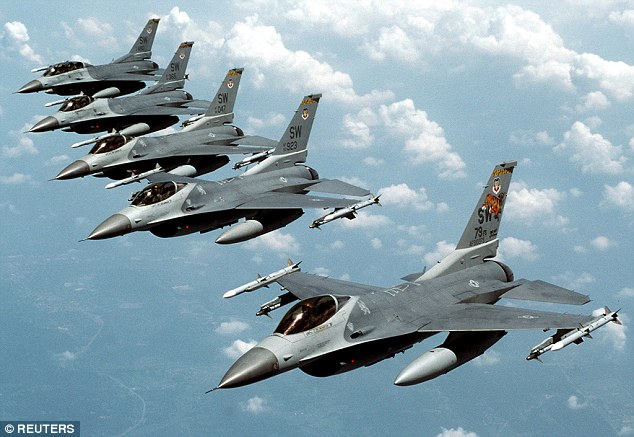
Fighting fit at forty: F-16 planes first flew in 1974 and are constantly updated with new technology
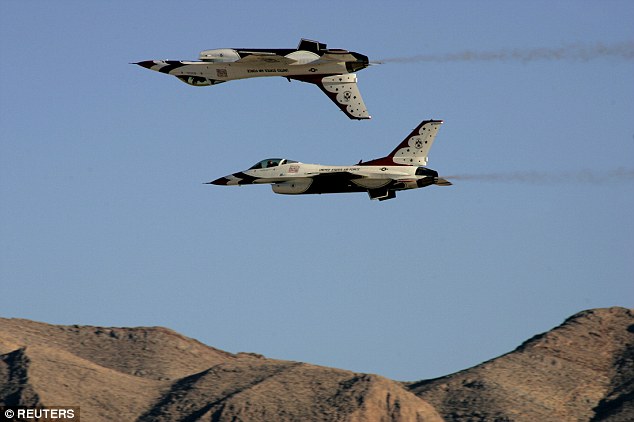
F-16 fighter planes show off their agility at the Aviation Nation air show near Las Vegas in 2004
Its creators at Lockheed Martin boast that the stealth jet 'combines advanced stealth capabilities with fighter aircraft speef and agility, fully fused sensor information, network-enabled operations and advanced logistics and sustainment’.
The f35.com website continues: ‘The F-35 is designed with the entire battlespace in mind, bringing new flexibility and capability to the United States and its allies.
‘Reliance on any single capability – electronic attack, stealth, etc – is not sufficient for success and survivability in the future.’
BUT HOW DO THEY COMPARE ON PAPER? THE F-35 VERSUS THE F-16 JET
F-35
Role: Stealth multirole fighter
First flight: December 15, 2006
Unit cost (not including engine):
F-35A - $98million
F-35B - $104million
F-35C - $116million
Number built: 115 (as of November 2014)
Length: 15.67m
Wingspan: 10.7m
Height: 4.33m
Max speed (F-35A): 1,930kph
Armament:
One of the most highly-anticipated features of the F-35 armament is the Small Diameter Bomb II (SBD II). It is superior to its predecessor, the SDB I, because of its tri-mode seeker capability.
The bomb is able to guide towards its target using laser, imaging infrared or radar homing.
It can hit moving targets as well as stationary ones in any weather, or at night, with unprecedented reliability and accuracy.
The 'super weapon' is predicted to be the most versatile air-to-ground munition in the Pentagon's air combat inventory.
The cost per SDB II is said to be around $250,000 and the DoD plans on buying as many as 17,000 of them.
F-16
Role: Multirole fighter, air superiority fighter
First flight: January 20, 1974
Unit cost:
F-16A/B - $14.6million
F-16C/D - $18.8million
Number built: 4,540+
Length: 15.06m
Wingspan: 9.96m
Height: 4.88m
Max speed (F-16C): 2,120kph at altitude
Combat history:
The F-16 has served in the Air Forces of 26 nations, including the U.S., Israel, Britain, Egypt, the Netherlands, Denmark and Norway.
During Operation Desert Storm, the 1991 assault on Iraq, F-16s flew more than 13,000 operations, more than any other Coalition aircraft.
The U.S. has employed the F-16 in operations over the Balkans, Afghanistan and Libya.
At its production peak in 1987, the F-16 team in Fort Worth was also making history, by producing 30 F-16s in just 30 days.
Thanks to frequent upgrades improving and incorporating new technologies into the cockpit, avionics, sensors and weapons, the aircraft has consistently become more reliable over its 40 year.
There are three main variants to the F-35: F-35A conventional takeoff and landing; the F-35B short take-off and vertical landing; and F-35C carrier-based catapulta-assisted take-off but arrested recovery aircraft.
The fifth-generation aircraft is designed to excel in electronic warfare, air-to-surface combat and air-to-air combat.
Its stealth technology allows it to avoid radar detection that previous fourth generation fighters cannot. It also carries its weapons and fuel internally so it cannot be ‘detected and tracked’.
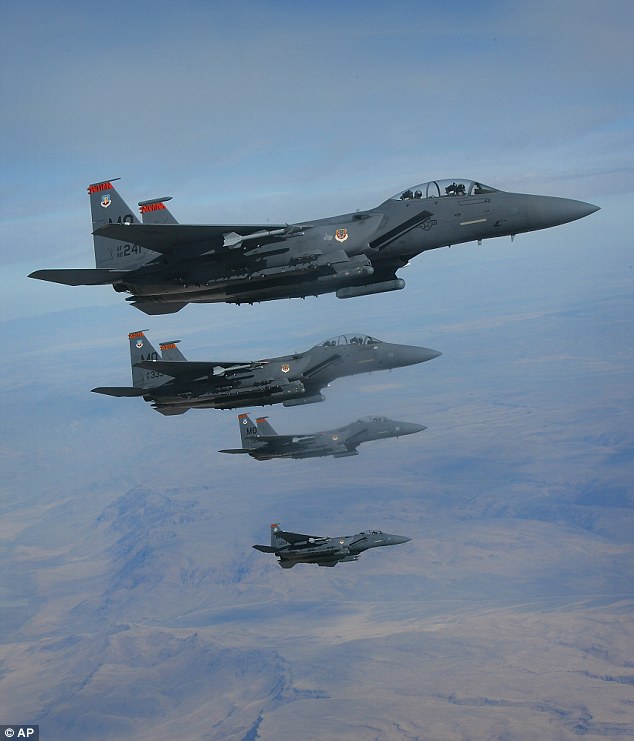
Old-timers: F-16s have flown in combat missions over Iraq, Afghanistan, the Balkans and Libya
The Royal Air Force has so far ordered eight F-35s to be delivered by next year.
The jets were meant to enter service in 2012, but Sir Nick Harvey, who served as the Minister of State for Armed Forces between 2010 and 2012, said that there was ‘not a cat in hell’s chance’ that the jet would be in British service by 2018.
‘I don’t recall…having heard anyone suggesting that these things could be used in combat before 2020.’
In total, Britain is expected to purchase 138 of the jets from the US, but at present costs that would add up to a total of $19billion.
The delays and escalating costs mean that once the British Tornado jets – which have been in service since 1979 - are retired in three years’ time, the UK will be left with an ‘offensive capacity’ of just 60 planes.
But the UK is not the only country waiting for the costly fighter jet to be fixed.
US Vice President Joe Biden promised a delivery of the jets to Israel ‘next year’, amid reports that Tel Aviv has approved a new deal to add 14 more jets to its 2010 order for 19 aircraft, according to RT.com.
Paralyzed woman flies F-35 fighter jet using her mind
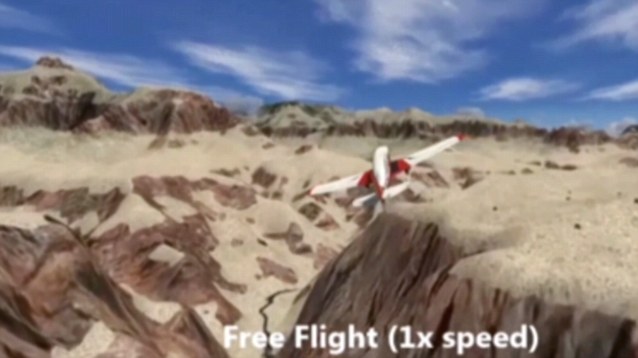
US latest F-35 stealth jet is beaten in dogfight by F-16 from 1970s | Daily Mail Online
- The F-35 stealth jet has already cost the military more than $350billion
- But in a mock battle it was outperformed by an F-16 designed in the 1970s
- F-35 test pilot said new plane was too cumbersome to dodge enemy fire
- He deemed it totally inappropriate for fighting aircraft within visual range
Published: 17:36 GMT, 30 June 2015 | Updated: 20:29 GMT, 30 June 2015
It’s the most expensive weapon in history but America's F-35 stealth jet has been outperformed by a 40-year-old F-16 jet in a dogfight.
A mock air battle was held over the Pacific Ocean between the cutting-edge F-35 - meant to be the most sophisticated jet ever - and an F-16, which was designed in the 1970s.
But according to the test pilot, the F-35 is still too slow to hit an enemy plane or dodge gunfire. So far it has cost the US military more than $350billion.
Scroll down for video

Head-to-head: The F-35 (background) and the F-16 (foreground) took to the skies in a dogfight to determine how the highly-anticipated F-35 compares to its predecessor
The dogfight, which was staged in January near Edwards Air Force Base, California, was designed to test the F-35’s ability in close-range combat at 10,000 to 30,000 feet.
Both the F-35 pilot and the F-16 pilot were attempting to ‘shoot down’ the other.
But, according to the F-35 pilot’s report, which has only recently been made public, the jet performed so appallingly that he deemed it completely inappropriate for fighting other aircraft within visual range.
He reported that the F-35 – designed by Lockheed Martin – was at a ‘distinct energy disadvantage for every engagement’ despite the F-16 being weighed down by two drop tanks for extra fuel.
The F-35 pilot reported a number of aerodynamic problems, including ‘insufficient pitch rate’ for the jet’s nose while climbing - resulting in the plane being too cumbersome to dodge enemy fire.
He said that a half-million-dollar custom-made helmet that gives pilots a 360-degree view outside the plane meant he was unable to comfortably move his head inside the cramped cockpit. This meant the F-16 could approach from behind without him noticing.
‘The helmet was too large for the space inside the canopy to adequately see behind the aircraft,’ he wrote in the five-page brief.

'Flying computer': U.S. military leaders have extoled the virtues of the F-35 jets, which are intended to 'combine advanced stealth capabilities with fighter aircraft speed and agility'

But a series of setbacks has delayed production by up to eight years and put it $263billion over budget so far
See through the eyes of an F-35 fighter pilot's high tech helmet

The F-35 jet was one of the most highly anticipated advancements in military history.
However a series of setbacks has delayed production by up to eight years and put it $263billion over budget so far.
The spiralling costs are due to a number of factors, including engine problems that caused one jet to burst into flames during take-off last May.
Air Force Lt. Gen. Chris Bogdan, who is in charge of the F-35 programme, said the planes had been plagued by simple mistakes. These included everything from wingtip lights that did not meet Federal Aviation Administration (FAA) standards to tires that could not cope with the landings.

Britain's baby: This F-35 is intended for use by the RAF, although an official said it won't be ready for years
But military bosses have been quick to extol the virtues of the stealth multirole fighter, which is predicted to be vastly superior to its fourth-generation predecessors.
Marine Lt Gen. Robert Schmidle said the planes were like flying computers and that they could detect an enemy five to 10 times faster than the enemy could detect it.
And Lt Col David Burke told 60 Minutes last year: ‘I’m telling you, having flown those other airplanes, it’s not even close at how good this airplane is and what this airplane will do for us.’

Fighting fit at forty: F-16 planes first flew in 1974 and are constantly updated with new technology

F-16 fighter planes show off their agility at the Aviation Nation air show near Las Vegas in 2004
Its creators at Lockheed Martin boast that the stealth jet 'combines advanced stealth capabilities with fighter aircraft speef and agility, fully fused sensor information, network-enabled operations and advanced logistics and sustainment’.
The f35.com website continues: ‘The F-35 is designed with the entire battlespace in mind, bringing new flexibility and capability to the United States and its allies.
‘Reliance on any single capability – electronic attack, stealth, etc – is not sufficient for success and survivability in the future.’
BUT HOW DO THEY COMPARE ON PAPER? THE F-35 VERSUS THE F-16 JET
F-35
Role: Stealth multirole fighter
First flight: December 15, 2006
Unit cost (not including engine):
F-35A - $98million
F-35B - $104million
F-35C - $116million
Number built: 115 (as of November 2014)
Length: 15.67m
Wingspan: 10.7m
Height: 4.33m
Max speed (F-35A): 1,930kph
Armament:
One of the most highly-anticipated features of the F-35 armament is the Small Diameter Bomb II (SBD II). It is superior to its predecessor, the SDB I, because of its tri-mode seeker capability.
The bomb is able to guide towards its target using laser, imaging infrared or radar homing.
It can hit moving targets as well as stationary ones in any weather, or at night, with unprecedented reliability and accuracy.
The 'super weapon' is predicted to be the most versatile air-to-ground munition in the Pentagon's air combat inventory.
The cost per SDB II is said to be around $250,000 and the DoD plans on buying as many as 17,000 of them.
F-16
Role: Multirole fighter, air superiority fighter
First flight: January 20, 1974
Unit cost:
F-16A/B - $14.6million
F-16C/D - $18.8million
Number built: 4,540+
Length: 15.06m
Wingspan: 9.96m
Height: 4.88m
Max speed (F-16C): 2,120kph at altitude
Combat history:
The F-16 has served in the Air Forces of 26 nations, including the U.S., Israel, Britain, Egypt, the Netherlands, Denmark and Norway.
During Operation Desert Storm, the 1991 assault on Iraq, F-16s flew more than 13,000 operations, more than any other Coalition aircraft.
The U.S. has employed the F-16 in operations over the Balkans, Afghanistan and Libya.
At its production peak in 1987, the F-16 team in Fort Worth was also making history, by producing 30 F-16s in just 30 days.
Thanks to frequent upgrades improving and incorporating new technologies into the cockpit, avionics, sensors and weapons, the aircraft has consistently become more reliable over its 40 year.
There are three main variants to the F-35: F-35A conventional takeoff and landing; the F-35B short take-off and vertical landing; and F-35C carrier-based catapulta-assisted take-off but arrested recovery aircraft.
The fifth-generation aircraft is designed to excel in electronic warfare, air-to-surface combat and air-to-air combat.
Its stealth technology allows it to avoid radar detection that previous fourth generation fighters cannot. It also carries its weapons and fuel internally so it cannot be ‘detected and tracked’.

Old-timers: F-16s have flown in combat missions over Iraq, Afghanistan, the Balkans and Libya
The Royal Air Force has so far ordered eight F-35s to be delivered by next year.
The jets were meant to enter service in 2012, but Sir Nick Harvey, who served as the Minister of State for Armed Forces between 2010 and 2012, said that there was ‘not a cat in hell’s chance’ that the jet would be in British service by 2018.
‘I don’t recall…having heard anyone suggesting that these things could be used in combat before 2020.’
In total, Britain is expected to purchase 138 of the jets from the US, but at present costs that would add up to a total of $19billion.
The delays and escalating costs mean that once the British Tornado jets – which have been in service since 1979 - are retired in three years’ time, the UK will be left with an ‘offensive capacity’ of just 60 planes.
But the UK is not the only country waiting for the costly fighter jet to be fixed.
US Vice President Joe Biden promised a delivery of the jets to Israel ‘next year’, amid reports that Tel Aviv has approved a new deal to add 14 more jets to its 2010 order for 19 aircraft, according to RT.com.
Paralyzed woman flies F-35 fighter jet using her mind

US latest F-35 stealth jet is beaten in dogfight by F-16 from 1970s | Daily Mail Online
